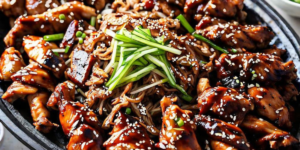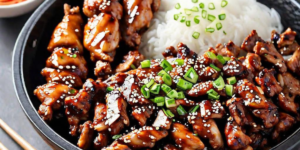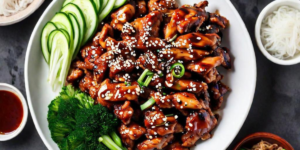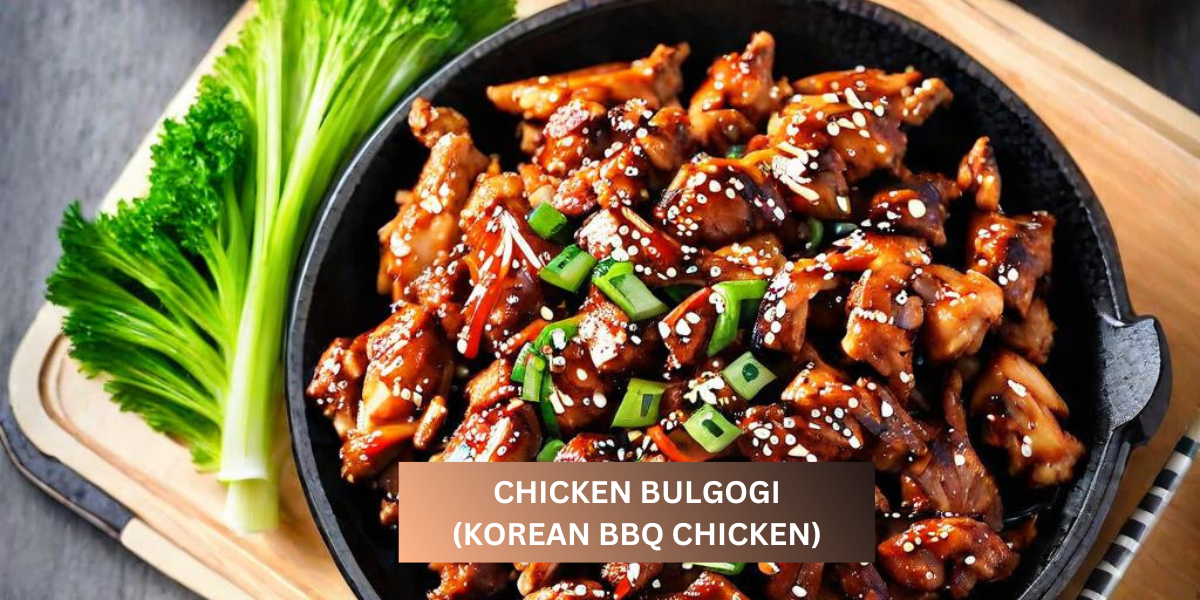INTRODUCTION
Recipe for a simple Korean chicken bulgogi dish. What is the best way to prepare Korean barbecue chicken at home? This Korean BBQ Chicken, which is widely referred to as chicken bulgogi or dak bulgogi (십 불고기), is marinated in a soy-based marinade that causes the chicken to become soft and imparts great flavor. Not only is this dish incredibly tasty, but it is also very simple to prepare. To make matters even better, you should be able to locate all of the required components at the grocery stores that you typically shop at. Now is the time to start the cooking!
As a Korean barbecue chicken dish, chicken bulgogi is a straightforward and speedy dish that is made using gochujang. Whether you like to grill, broil, or pan-fry this chicken, it has a somewhat sweet and delicious flavor. The ideal dish for a meal during the week! In the moment that you hear the word “bulgogi,” your mind quickly goes to the well-known Korean barbecue beef dish. On the other hand, Bulgogi does not restrict the amount of beef. You will be pleasantly pleased by the delicious flavor of chicken if you give this Chicken bulgogi, also known as Korean BBQ chicken, a try.
The vast majority of bulgogi chicken recipes call for a spice that is based on soy sauce and has a distinctively savory flavor. Gochujang, which is a Korean chili paste, is the seasoning that I favor the most when it comes to my bulgogi chicken. You might end yourself loving it just as much as I do! Cooking chicken bulgogi on a grill is the traditional technique of preparation; however, you can also use other cooking methods, such as broiling or pan-frying the chicken.
WHAT IS CHICKEN BULGOGI
The bulgogi dish known as chicken bulgogi is cooked with chicken. I have previously provided an explanation of the phrase – bulgogi – in my bulgogi recipe; however, I will provide a quick explanation once more. It is commonly prepared with the tender sections of beef, pork, or chicken, and the word “bulgogi” literally translates to “fire meat.” Nevertheless, in general, beef is used in the preparation of bulgogi, unless otherwise specified.

As a result of the fact that I am referring to “chicken bulgogi” in this context, it is not difficult to understand that this dish is about chicken fire meat. A few of my readers have already begun preparing chicken bulgogi with the beef bulgogi marinade that I recently shared with them. During the course of this round of recipe testing, I even gave that a shot myself. On the other hand, I discovered that the beef bulgogi marinade did not work well with the chicken flavor. The flavor seemed to be a little too faint for the chicken, in my opinion. It works wonderfully with beef, especially rib eye, so don’t be concerned about that!
I have conducted a number of trials in order to develop a marinade for my chicken bulgogi, and I would want to share it with you today.
SECRET INGREDIENT IN CHICKEN BULGOGI MARINADE
The majority of the components that I use in the marinades for my chicken bulgogi are the same as those that I use in my beef bulgogi recipe. On the other hand, I substituted a soft drink named Sprite for the fruit that I had planned to add. I have no doubt that you are familiar with it.
In any case, it was exceptionally effective in tenderizing my chicken (although, in general, there is not much of a need to tenderize chicken), and it provided a pleasant sweetness to the dish. In addition to that, it is possible to use other types of carbonated lemon-lime soda, such as 7 Up or something comparable.
If you were to ask me, would a Coca-Cola be a suitable substitute? Indeed, I attempted to use it as well; but, the chicken did not turn out as soft as it did when I used Sprite. Additionally, the flavor that I received with Sprite is my favorite. In addition, it is possible that certain individuals in Korea may employ plum extract, also known as maesil cheong (姤실청), as a unique flavoring component. That led to a positive outcome as a result. To tell you the truth, it was my second favorite option, right behind Sprite. On the other hand, it offers a more robust flavor at the beginning and the conclusion, which meant that I was unable to taste the other components of the marinade as much. On the other hand, I favor using lemonade as my primary option.
COOKING THE CHICKEN
If you want your barbecue chicken to have a flavor similar to that of a char grill, you should cook it on a barbecue grill. In particular, grilling food directly over a charcoal grill will result in an outstanding outcome. On the other hand, if you are looking for a more convenient option for weeknights, you can stir fried the chicken in a skillet.
It should come as no surprise that the method of cooking used for the chicken would result in a somewhat different texture and flavor of the chicken. Regardless of the way that you use, you will be able to obtain the mouthwateringly flavorful Korean barbecue chicken!

SERVING SUGGESTIONS
The manner in which the chicken is cooked is likely to be the deciding factor in the serving decision. Under normal circumstances, I would serve it with a Korean green salad and possibly some kimchi if I cooked it on a barbecue grill. In the event that you are looking for some carbohydrates, you might also consider Korean macaroni salad.
If, on the other hand, I am preparing it in a skillet, I prefer to serve it with some rice that has been steamed and some veggies that have been grilled or steamed (for example, broccoli, broccolini, or bell peppers). This choice is ideal for a hectic meal throughout the weekday. Serve it with lettuce leaves, perilla leaves, and ssamjang, which is a Korean barbecue dipping sauce. This will also provide you the opportunity to create a traditional Korean barbecue experience. On the other hand, you are free to serve it with whatever else that your heart desires!
INGREDIENTS
MAIN
- This recipe calls for 450 grams, or one pound, of boneless, skinless chicken thighs. However, you are free to use any other type of chicken cut you like.
CHICKEN BULGOGI MARINADE
- 3 tablespoons of ordinary soy sauce
- Brown sugar, 1.5 tablespoons
- 1 teaspoon of rice wine
- It is possible to substitute 7 Up or any carbonated lemon-lime soda for the 1/4 cup of Sprite that is currently being used.
- 1/2 tablespoon of garlic that has been minced
- 1 teaspoon of ginger that has been minced
- 1 milligram of sesame oil
- black pepper that has been ground
HOW TO MAKE CHICKEN BULGOGI
- Cut the chicken into pieces that are easily digestible. When grilling, make sure to prepare it according to the type of grill you have and your own liking.
- Take all of the ingredients for the marinade and combine them in a bowl. Mix them thoroughly. Assemble it on top of the meat. Cover it and marinate it in the refrigerator for at least four hours or overnight to bring out the full taste of the dish. It is possible to marinade it for a significantly shorter period of time; nevertheless, the chicken will have a reduction in flavor.
- Chicken should be cooked in a skillet that has been preheated. Cook the chicken in accordance with the instructions provided by your grill manual. There is no need to add the remaining marinade. Using a slotted spoon helps me reduce the amount of marinade that is transferred. After allowing the chicken to sizzle on all sides over medium-high heat, reduce the heat to medium and continue cooking the chicken until it is thoroughly done.
- During this interim period, take a separate sauce pan and bring the remaining marinade to a boil over medium-high heat for two to three minutes, stirring the mixture occasionally. The sauce should be strained through a sieve to remove any extra fat and unwanted particles. Keep the sauce to the side.
- Deliver. Apply a glaze to the chicken using the sauce.

CONCLUSION
Bringing the bright flavors of Korean barbecue into your home kitchen, Chicken Bulgogi gives you the opportunity to enjoy a dining experience that is both tasty and unforgettable. This dish is sure to satisfy and impress you with its tempting combination of sweet, salty, and spicy flavors. It is perfect for those who are just beginning their journey into the world of Korean cuisine or those who are eager to expand their already extensive culinary repertoire. Take pleasure in the process of preparing and consuming Chicken Bulgogi with your loved ones and friends, and allow the tastes of this dish to take you to the lively streets of Seoul.
FREQUENTLY ASKED QUESTIONS (FAQ’s)
1. What is chicken bulgogi made of?
Ans. Since chicken is used in the preparation of Dak bulgogi, I find that I sometimes prefer it over the beef version. After the thicker chicken thighs have absorbed the marinade that contains garlic and soy sauce, they are swiftly grilled until the marinade becomes caramelized on the outside while the chicken thighs continue to retain their juicy inside.
2. Is bulgogi the same as Korean BBQ?
Ans. “Fire meat” is the literal translation of the Korean word bulgogi, which is one of the most popular forms of Korean barbecue. Before being grilled over an open flame, the soft meat, which is made from thin slices of sirloin, pig belly, or tenderloin, is marinated with a large number of spices with the intention of imparting an even more robust flavor.
3. What does Korean bulgogi taste like?
Ans. The marinade of soy sauce, sesame oil, garlic, and ginger gives beef bulgogi a flavor profile that is pleasantly sweet, savory, and smoky. The beef bulgogi is insanely soft and juicy. A tantalizingly tasty and extremely flavorful dish, it is truly a treat. Since this Bulgogi cooks quite quickly, once your steak has finished marinating, you will have fifteen minutes till dinnertime!
4. Is Korean bulgogi healthy?
Ans. Despite the fact that it is loaded to the gills with vegetables, it nevertheless has a wicked flavor because to the sweet and salty bulgogi sauce topping. When it comes to “healthy-ish comfort food,” it is very much what you would call perfect.
5. Is bulgogi a spicy food?
Ans. When compared to beef bulgogi, pork bulgogi is typically cooked with a significant amount of Korean red chili pepper paste that is used in the cooking process. Oh, it’s quite fiery! My guess is that the vast majority of the recipes for pork bulgogi that can be found on the internet involve this spicy variant. The city of Seoul also offers a variant that is not spicy.
6. Is bulgogi beef or pork?
Ans. To make bulgogi, thin slices of sirloin or other prime cuts of beef are used as the primary ingredients. Ribeye is another dish that is frequently utilized because of its tenderness and the fact that it can be chopped easily. The preparation of bulgogi often involves the use of a variety of products, including beef, poultry, and pork, among others.
7. How to eat bulgogi?
Ans. When you are ready to eat, take a lettuce leaf and wrap it around a spoonful of rice, a piece of bulgogi, and a small amount of ssamjang. Eat it after you fold it over. Let it be!
8. What are the three types of bulgogi?
Ans. There are three distinct styles of bulgogi that are commonly offered in restaurants nowadays. These styles include the Gwangyang-style, which originates from South Jeolla Province, the Eonyang-style, which originates from South Gyeongsang Province, and the Seoul-style, which is the last but not the least.
9. What makes bulgogi special?
Ans. The fact that bulgogi is “roasted meat that has been sliced and marinated” is the distinctive feature that stands out the most. The history of Korean roast beef that has been marinated may be traced back to the Goguryeo dynasty, which lasted from 37 BC to AD 668. During this time, the dish was known as maekjeok, which is equivalent to pre-marinated roasted meat on a skewer.
10. What is bulgogi called?
Ans. The term “bulgogi” originates from Korea and literally means “fire meat.” This is because the original method of preparation involved cooking the meat on skewers over a hwaro grill. Maekjeok was the name given to this popular supper when it was first introduced during the Goguryeo period (37 B.C. to 668 A.D.). Its early history and provenance date back to this time period.

